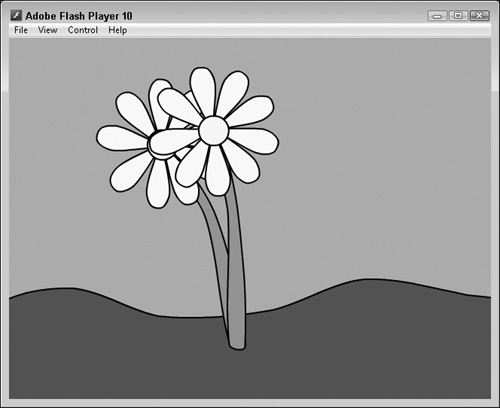Flash Export Issues
Even if you optimize the project, there are some export issues that you need to be aware of, or they can cause trouble for you.
Clearing Animated Content
One problem that can arise when an animated project is exported to the SWF format is that the content on the last frame of the animation remains when the animation loops to start again. This can really disrupt the flow of a looping animation. Figure 34.4 shows this problem with the dancing flower. Notice how the last frame of the flower stays around after the animation has finished and when it loops to start again, the flower is still there.
Note
This problem is inconsistent. It tends to happen more often with larger files.
Luckily, Anime Studio includes a simple fix for this problem. In the Project Settings dialog box is an Extra SWF Frame option. This option causes a blank frame to be automatically added to the end of the animation. This blank frame clears the screen so that when the animation loops, the animation starts with a clear screen.
Caution
If your exported animation is a short looping clip, then the Extra SWF Frame option might cause an annoying flicker.
Releasing Bone Control
If an image layer is bound to a bone, then it cannot be exported. You can determine this by looking for the red optimization dot in the Layers palette by the layer’s icon. If you have an image layer that is within a bone or a switch layer that you know isn’t controlled by a bone that isn’t being exported, then you can ensure that it will be exported by selecting the layer and using the Bone, Release Layer menu command. This removes the bone binding for the layer, and the red optimization dot should reappear for this layer.
Working with MP3s
Anime Studio lets you add audio files that are WAV (for Windows) or AIFF files (for Mac), but these audio formats are uncompressed and result in larger file sizes. You can use highly compressed MP3 audio files in your exported SWF files, which helps to keep the file sizes down.
To use the MP3 file, you’ll need to add the WAV or AIFF file to the project and then convert the same audio file to the MP3 format. Place the converted MP3 file in the same folder as the WAV or AIFF file and name it the same. When the file is exported to the SWF format, the MP3 file is used in place of the larger WAV or AIFF file.
Anime Studio doesn’t include the ability to convert audio files from the WAV or AIFF formats to MP3, but there are several programs that can easily do it, including iTunes and Audacity, as well as the major audio editing packages.
Note
The ability to use MP3s works when exporting to QuickTime also.
To export a project with sound to the Flash (SWF) format, follow these steps:
1. | Open the Dancing flower.anme file from the Chapter 34 folder on the CD. This file is taken from an earlier tutorial and features a flower that moves to the beat of an audio file. |
2. | Convert the TutDrum.wav file to a MP3 file using an audio editing program or iPod software. A copy of a converted file is located in the Chapter 34 folder on the CD. Place the converted MP3 file in the same folder as the WAV file. |
3. | Select the File, Export Animation menu command (Ctrl/Cmd+E). In the Export Animation dialog box, select the Render at Half Dimensions option to speed up the exporting process. Then choose the Flash (SWF) option from the Output Format drop-down list and click the OK button. |
4. | |
5. | To view the exported file, drag the exported SWF file and drop it on an open Web browser. The file will open and play with sound in the Flash player, as shown in Figure 34.5. |
Avoid Large Frame Ranges
The Flash export feature sometimes has trouble when trying to export an animation with a large number of frames. Generally, animations with over 500 frames will have trouble. You can overcome this trouble by exporting the animation using smaller batches of 50 to 100 frames. The smaller sequences can then be recombined using Flash.
Tip
You can render multiple smaller frame ranges at once using the Batch Render dialog box. The Batch Render also lets you do background renders, so you could render frames 1–100 using the File, Export feature and then start frames 101–200 using Batch Render and both will render simultaneously.
Controlling Looping
Animations in Anime Studio that are exported to SWF will automatically loop indefinitely, and Anime Studio doesn’t include a command forcing the animation to play only once. If you want your animation to play through only once, you could load the SWF file into Flash and add a stop command to the end of the project, or you could add the loop=no command to the HTML page that is calling the SWF file. When the SWF file is playing in the browser, you can right-click the browser and disable the Loop option in the pop-up menu.


